Eco-Friendly Pavements Manufactured with Glass Waste: Physical and Mechanical Characterization and Its Applicability in Soil Stabilization
Abstract
1. Introduction
- (1)
- (2)
- Improved durability based on its resistance to abrasion and acid attack [19].
- (3)
- Increased resistance to compression and elastic modulus after their exposure to high temperatures due to the fusion of the glass and filling of the cracks and pores [20].
- (4)
- Reinforcement of photocatalytic activity due to its light transmitting properties [12].
- (5)
- The leachates emitted when this type of cement material is used in the stabilization of soils are perfectly compatible with the environment [21].
2. Materials and Methods
2.1. Characterization of Materials
2.1.1. Aggregate
2.1.2. Cement
2.1.3. Glass Powder
Preliminary Sampling
Composition
Grinding
Granulometric Characterization of Glass Powder
X-ray Diffraction
Characterization in the Scanning Electron Microscope
Volumetric Mass of Glass Powders
2.2. Tests and Working Plan
- (1)
- Granulometry of the aggregate used according to UNE-EN-933-1: 2012 Second bullet [33].
- (2)
- (3)
- Compactability through the modified Proctor compaction test, according to UNE103501 standard [37].
- (4)
- The support capacity, through the California Bearing Ratio (CBR) following UNE 103502 [38].
- (5)
- (6)
- The resistance to the action of water, through the resistance test by immersion in water (immersion–compression), according to NLT-162 [41].
- (7)
- The stiffness test by testing Dynamic Modules (at different ages of the specimens), according to the NLT-349 standard [42].
- (8)
- (9)
- The durability of the pavement laid with the treated material, regarding resistance to traffic loads, was estimated by means of an analytical calculation made from the mechanical properties measured in the tests mentioned above.
3. Results
3.1. Limits of Atterberg
3.2. CBR Test
3.3. Modified Proctor
3.4. Compression Resistance
3.5. Immersion–Compression Resistance Test
3.6. Stiffness Test
3.7. Durability Test—Action of the Weather
3.8. Durability Test—Resistance to Traffic Loads
4. Conclusions
Author Contributions
Funding
Conflicts of Interest
References
- Reddy, M.S.; Neeraja, D. Mechanical and durability aspects of concrete incorporating secondary aluminium slag. Resour. Technol. 2016, 2, 225–232. [Google Scholar] [CrossRef]
- Omran, A.; Tagnit-Hamou, A. Performance of glass-powder concrete in field applications. Constr. Build. Mater. 2016, 109, 84–95. [Google Scholar] [CrossRef]
- Lu, J.-X.; Duan, Z.-H.; Poon, C.S. Fresh properties of cement pastes or mortars incorporating waste glass powder and cullet. Constr. Build. Mater. 2017, 131, 793–799. [Google Scholar] [CrossRef]
- Ghaffar, S.H.; Burman, M.; Braimah, N. Pathways to circular construction: An integrated management of construction and demolition waste for resource recovery. J. Clean. Prod. 2020, 244, 118710. [Google Scholar] [CrossRef]
- The United Nation. Sustainable Development Goals. United Nations Department of Public Information, 2015. Available online: https://sustainabledevelopment.un.org/sdgs (accessed on 21 November 2019).
- Blankendaal, T.; Schuur, P.; Voordijk, H. Reducing the environmental impact of concrete and asphalt: A scenario approach. J. Clean. Prod. 2014, 66, 27–36. [Google Scholar] [CrossRef]
- Serpa, D.; Silva, A.S.; De Brito, J.; Pontes, J.; Soares, D. ASR of mortars containing glass. Constr. Build. Mater. 2013, 47, 489–495. [Google Scholar] [CrossRef]
- Schwarz, N.; Cam, H.; Neithalath, N. Influence of a fine glass powder on the durability characteristics of concrete and its comparison to fly ash. Cem. Concr. Compos. 2008, 30, 486–496. [Google Scholar] [CrossRef]
- Bilodeau, A.; Malhotra, V.M. High-Volume Fly Ash System: Concrete Solution for Sustainable Development. ACI Mater. J. 2000, 97. [Google Scholar] [CrossRef]
- MirzaHosseini, M.; Riding, K.A. Influence of different particle sizes on reactivity of finely ground glass as supplementary cementitious material (SCM). Cem. Concr. Compos. 2015, 56, 95–105. [Google Scholar] [CrossRef]
- Ling, T.-C.; Poon, C.-S.; Wong, H.-W. Management and recycling of waste glass in concrete products: Current situations in Hong Kong. Resour. Conserv. Recycl. 2013, 70, 25–31. [Google Scholar] [CrossRef]
- Chen, J.; Poon, C.-S. Photocatalytic activity of titanium dioxide modified concrete materials – Influence of utilizing recycled glass cullets as aggregates. J. Environ. Manag. 2009, 90, 3436–3442. [Google Scholar] [CrossRef] [PubMed]
- Kou, S.; Poon, C. Properties of self-compacting concrete prepared with recycled glass aggregate. Cem. Concr. Compos. 2009, 31, 107–113. [Google Scholar] [CrossRef]
- Soliman, N.; Tagnit-Hamou, A. Development of ultra-high-performance concrete using glass powder – Towards ecofriendly concrete. Constr. Build. Mater. 2016, 125, 600–612. [Google Scholar] [CrossRef]
- Pade, C.; Guimaraes, M. The CO2 uptake of concrete in a 100 year perspective. Cem. Concr. Res. 2007, 37, 1348–1356. [Google Scholar] [CrossRef]
- Meyer, C. The greening of the concrete industry. Cem. Concr. Compos. 2009, 31, 601–605. [Google Scholar] [CrossRef]
- Aliabdo, A.A.; Elmoaty, A.E.M.A.; Aboshama, A.Y. Utilization of waste glass powder in the production of cement and concrete. Constr. Build. Mater. 2016, 124, 866–877. [Google Scholar] [CrossRef]
- Shi, C.; Zheng, K. A review on the use of waste glasses in the production of cement and concrete. Resour. Conserv. Recycl. 2007, 52, 234–247. [Google Scholar] [CrossRef]
- Ling, T.-C.; Poon, C.-S. Feasible use of large volumes of GGBS in 100% recycled glass architectural mortar. Cem. Concr. Compos. 2014, 53, 350–356. [Google Scholar] [CrossRef]
- Ling, T.-C.; Poon, C.-S. Use of recycled CRT funnel glass as fine aggregate in dry-mixed concrete paving blocks. J. Clean. Prod. 2014, 68, 209–215. [Google Scholar] [CrossRef]
- I Mas, M.; García, E.M.; Marco, L.J.; De Marco, J. Análisis de la Viabilidad Ambiental de la Utilización de Morteros Fabricados con Polvo de Vidrio en la Estabilización de Suelos. Inf. Tecnol. 2016, 27, 77–86. [Google Scholar] [CrossRef]
- Jani, Y.; Hogland, W. Waste glass in the production of cement and concrete–A review. J. Environ. Chem. Eng. 2014, 2, 1767–1775. [Google Scholar] [CrossRef]
- De Castro, S.; De Brito, J. Evaluation of the durability of concrete made with crushed glass aggregates. J. Clean. Prod. 2013, 41, 7–14. [Google Scholar] [CrossRef]
- Corinaldesi, V.; Gnappi, G.; Moriconi, G.; Montenero, A. Reuse of ground waste glass as aggregate for mortars. Waste Manag. 2005, 25, 197–201. [Google Scholar] [CrossRef] [PubMed]
- Idir, R.; Cyr, M.; Tagnit-Hamou, A. Use of fine glass as ASR inhibitor in glass aggregate mortars. Constr. Build. Mater. 2010, 24, 1309–1312. [Google Scholar] [CrossRef]
- Salamatpoor, S.; Salamatpoor, S. Evaluation of adding crushed glass to different combinations of cement-stabilized sand. Int. J. Geo-Engineering 2017, 8, 209. [Google Scholar] [CrossRef]
- Instituto Español del Cemento y sus Aplicaciones; Asociación Nacional de Fabricantes de Cales de España; Asociación Nacional Técnica de Estabilizados de Suelos y Reciclados de firmes. Manual de Estabilización de Suelos con Cemento o Cal; Spanish Institute of the Cement and its Applications: Madrid, Spain, 2010; ISBN 978-84-89702-23-3. [Google Scholar]
- Peaker, A.; Dupas, J.-M. Static and Dynamic Properties of Sand-Cement. J. Geotech. Eng. Div. 1979, 105, 419–436. [Google Scholar]
- Kukko, H. Stabilization of Clay with Inorganic By-Products. J. Mater. Civ. Eng. 2000, 12, 307–309. [Google Scholar] [CrossRef]
- Wartman, J.; Grubb, D.G.; Strenk, P. Engineering Properties of Crushed Glass-Soil Blends. In Geotechnical Engineering for Transportation Projects; American Society of Civil Engineers (ASCE) Library: Reston, VA, USA, 2004; pp. 732–739. [Google Scholar] [CrossRef]
- Grubb, D.G.; Gallagher, P.M.; Wartman, J.; Liu, Y.; Carnivale, M. Laboratory Evaluation of Crushed Glass–Dredged Material Blends. J. Geotech. Geoenviron. Eng. 2006, 132, 562–576. [Google Scholar] [CrossRef]
- Del Toro, E.M.G.; López, M.I.M. Study of new formations of C-S-H in manufactured with glass powder as binder mortar. Ing. e Investig. 2018, 38, 24–32. [Google Scholar] [CrossRef]
- UNE-EN 933-1: Ensayos Para Determinar Las Propiedades Geometrícas de Los áridos; Asociación Española de Normalización y Certificación (AENOR): Madrid, Spain, 2012.
- NTL 310_90.: Compactación Con Martillo Vibrante de Materiales Granulares Tratados; Centro de Estudios y Experimentación de Obras Públicas (CEDEX): Madrid, Spain, 1990.
- NLT-105_98.pdf: Límite líquido Por el Método de la Cuchara de Casagrande; Centro de Estudios y Experimentación de Obras Públicas (CEDEX): Madrid, Spain, 1998.
- UNE 103-103-94: Determinación del Límite líquido de un Suelo Por el Método del Aparato de Casagrande; Asociación Española de Normalización y Certificación/Comités Técnicos (AEN/CTN): Madrid, Spain, 1998.
- UNE 103501:1994: Ensayo de Compactación. Proctor Modificado; Asociación Española de Normalización y Certificación (AENOR): Madrid, Spain, 1994.
- UNE103502:1995: Método de Ensayo Para Determinar en Laboratorio el índice C.B.R. de un Suelo; Asociación Española de Normalización y Certificación (AENOR): Madrid, Spain, 1995.
- NLT 304_89: Resistencia a Compresión Diametral de Materiales Tratados Con Conglomerantes Hidráulicos; Centro de Estudios y Experimentación de Obras Públicas (CEDEX): Madrid, Spain, 1989.
- NLT 305-90: Resistencia a Compresión Simple de Materiales Tratados Con Conglomerantes Hidráulicos; Centro de Estudios y Experimentación de Obras Públicas (CEDEX): Madrid, Spain, 1990.
- NLT162_84: Ensayo de Inmersión-compresión; Centro de Estudios y Experimentación de Obras Públicas (CEDEX): Madrid, Spain, 1984.
- NLT 349_90: Médida de Módulos Dinámicos de Materiales Para Carreteras; Centro de Estudios y Experimentación de Obras Públicas (CEDEX): Madrid, Spain, 1990.
- NLT302_72: Humedad-Sequedad de Probetas de Suelo-Cemento; Centro de Estudios y Experimentación de Obras Públicas (CEDEX): Madrid, Spain, 1996.
- NLT303_72: Congelación-Deshielo de Probetas de Suelo-Cemento; Centro de Estudios y Experimentación de Obras Públicas (CEDEX): Madrid, Spain, 1996.
- Boletín Oficial del Estado, Suelos Estabilizados in Situ 512. 2015. Available online: http://www.carreteros.org/normativa/pg3/ordenes/ministeriales/fom2523_2014/512.pdf (accessed on 3 January 2015).
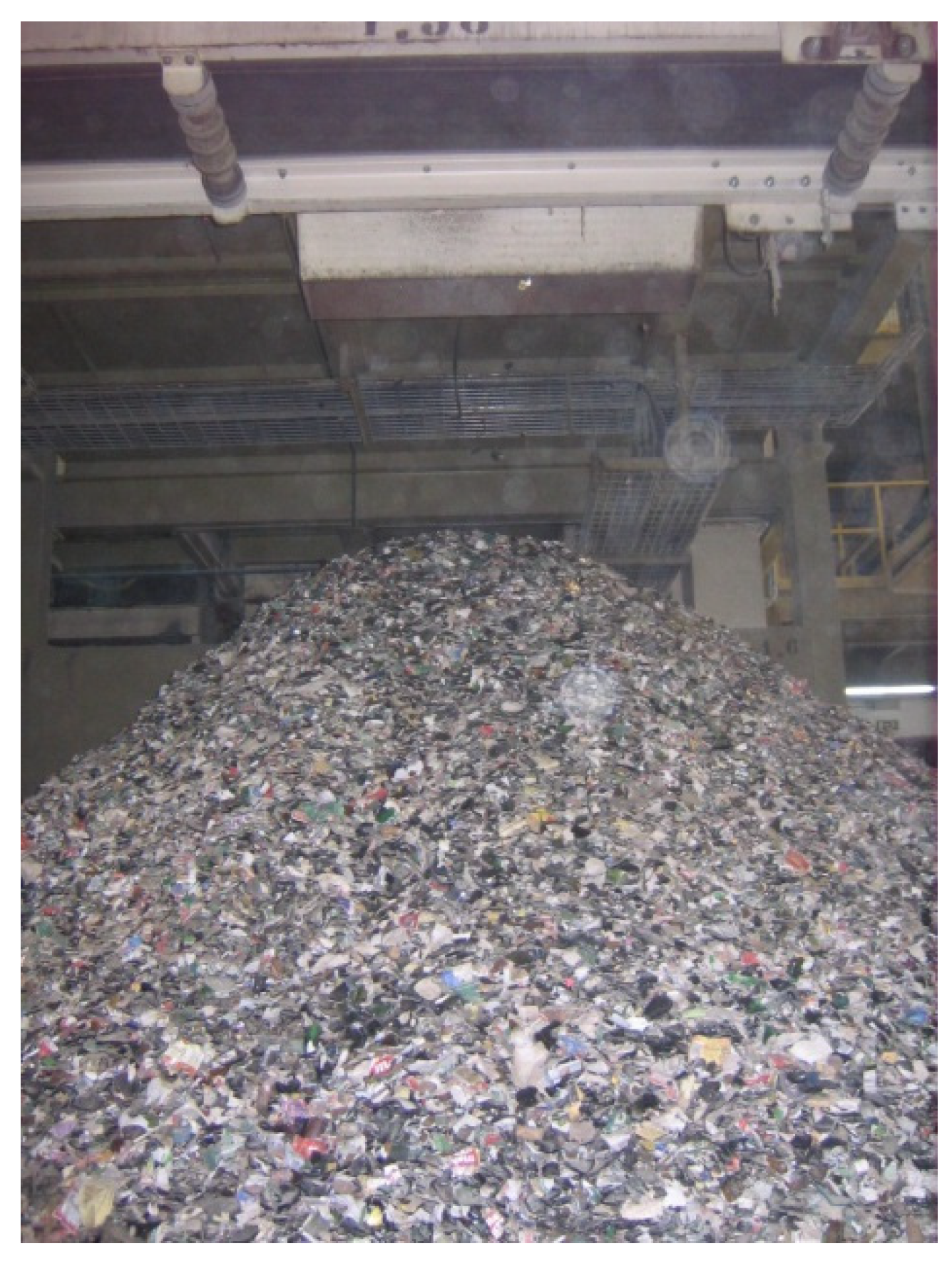
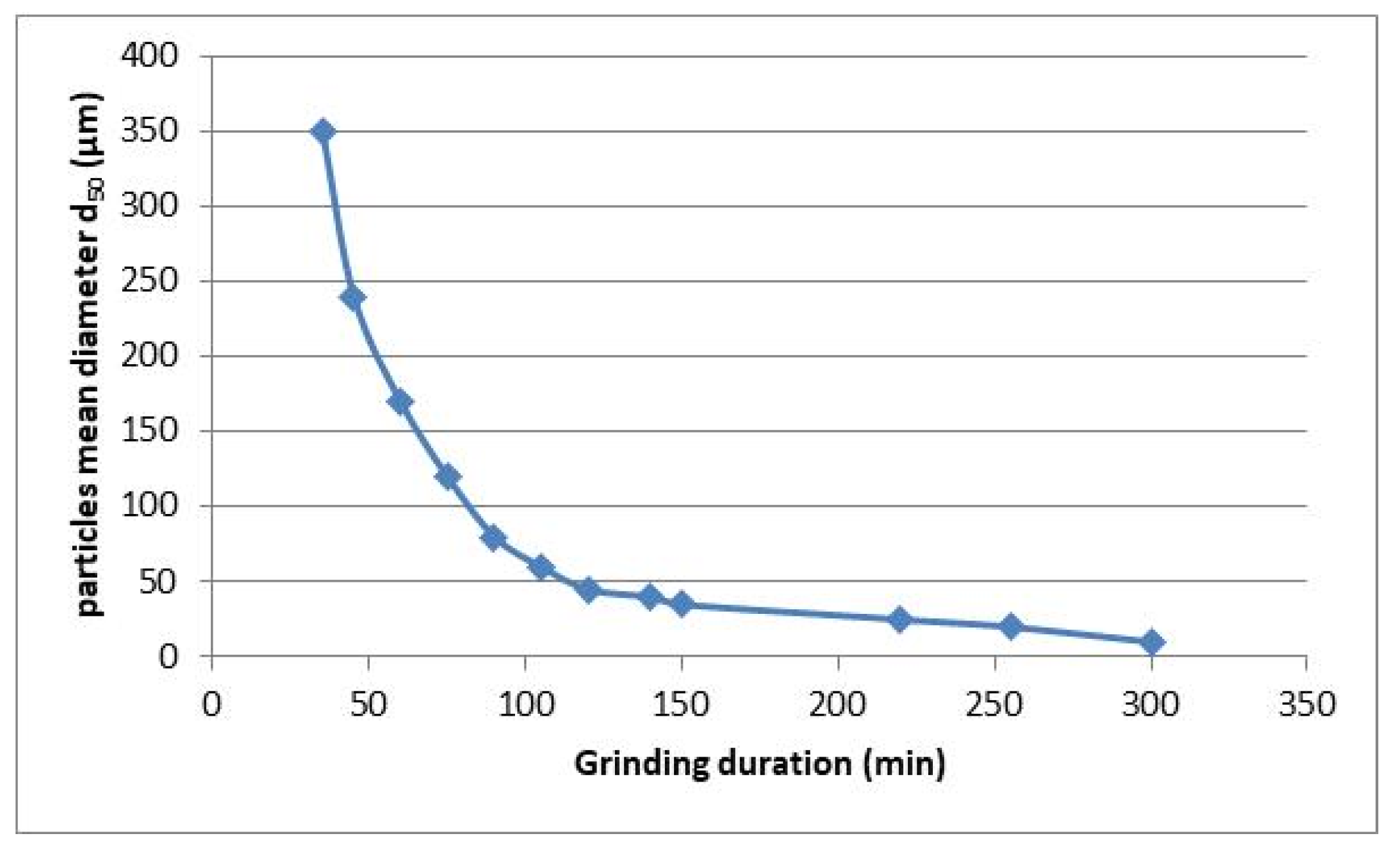

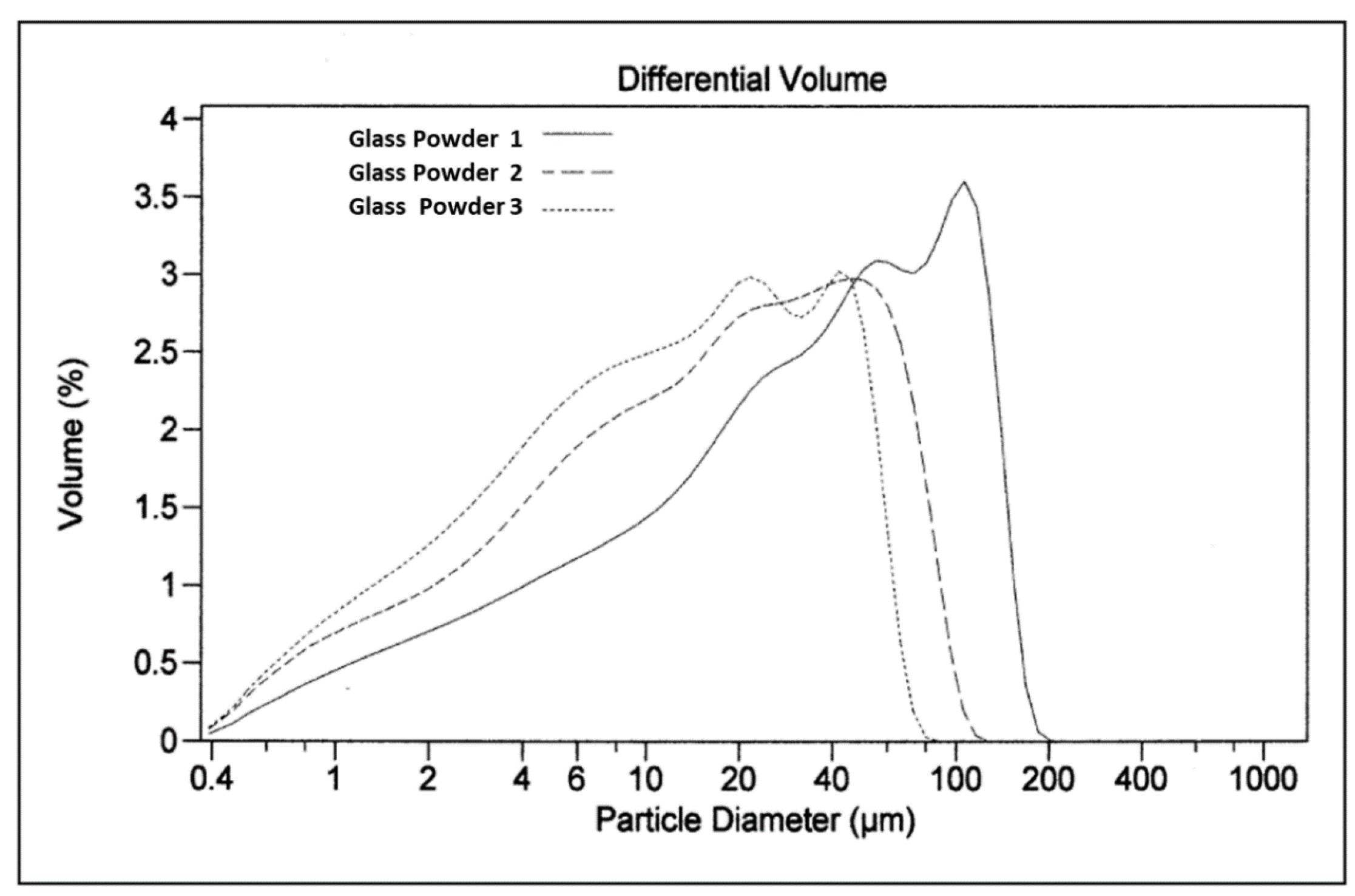
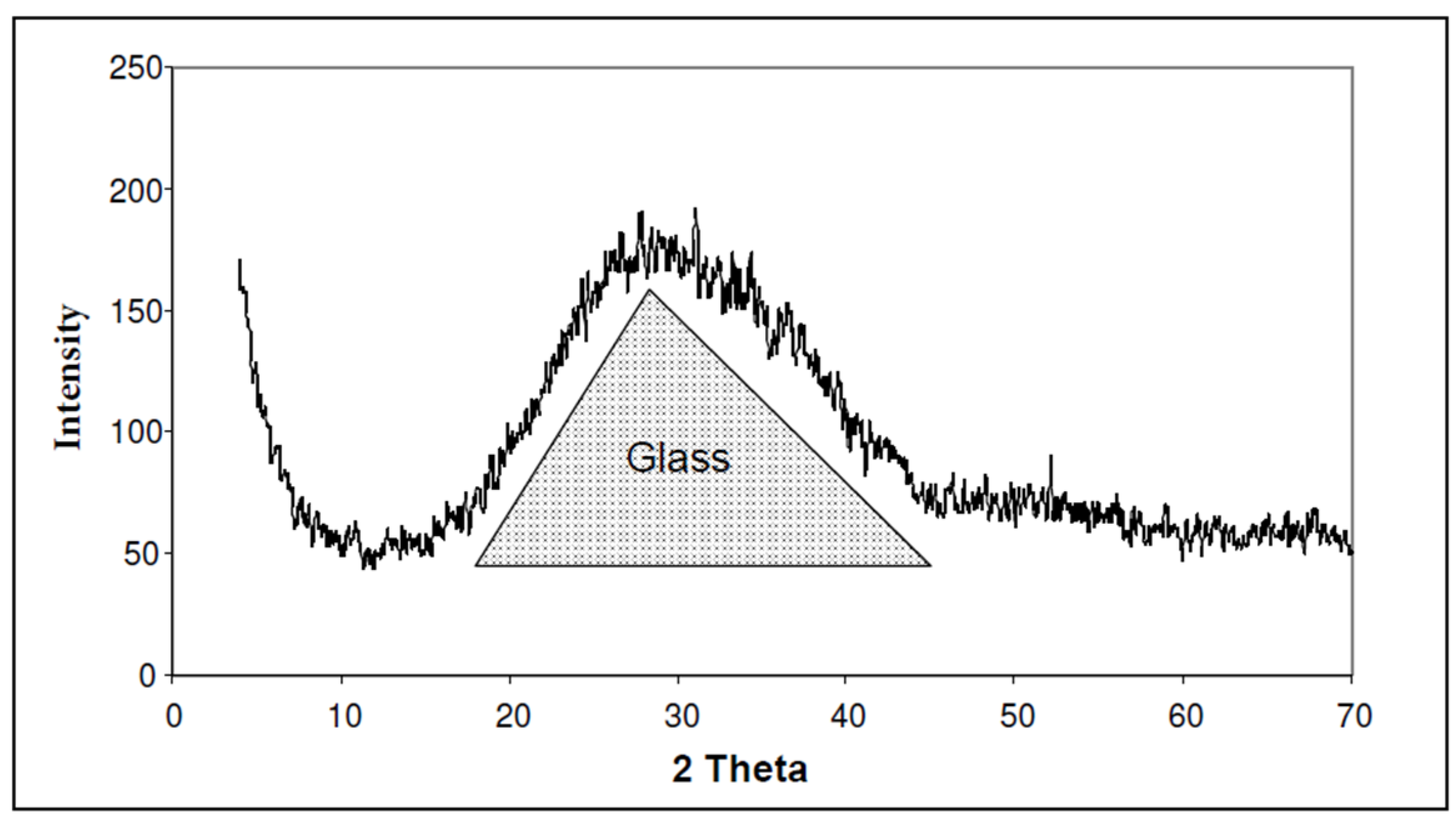

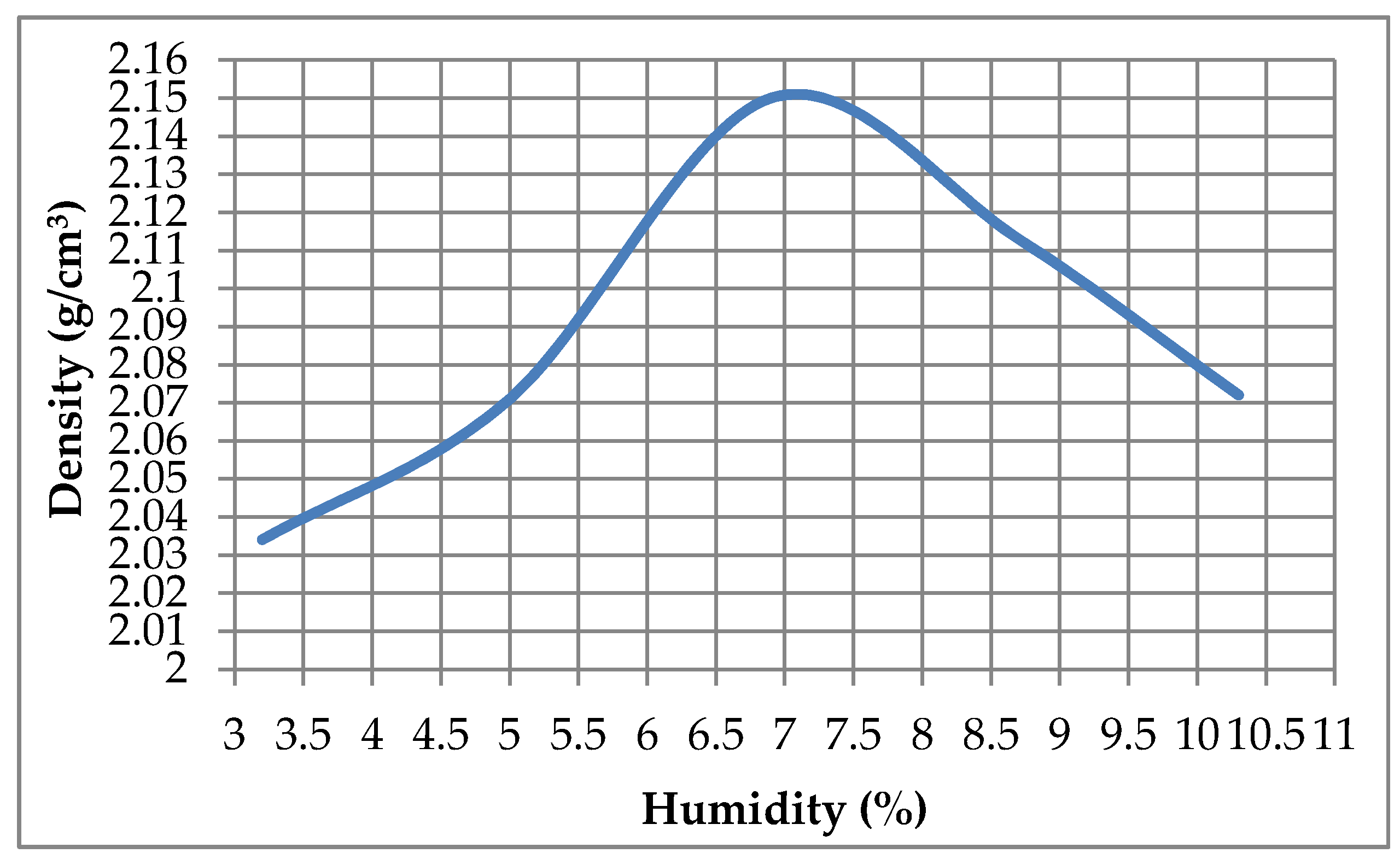

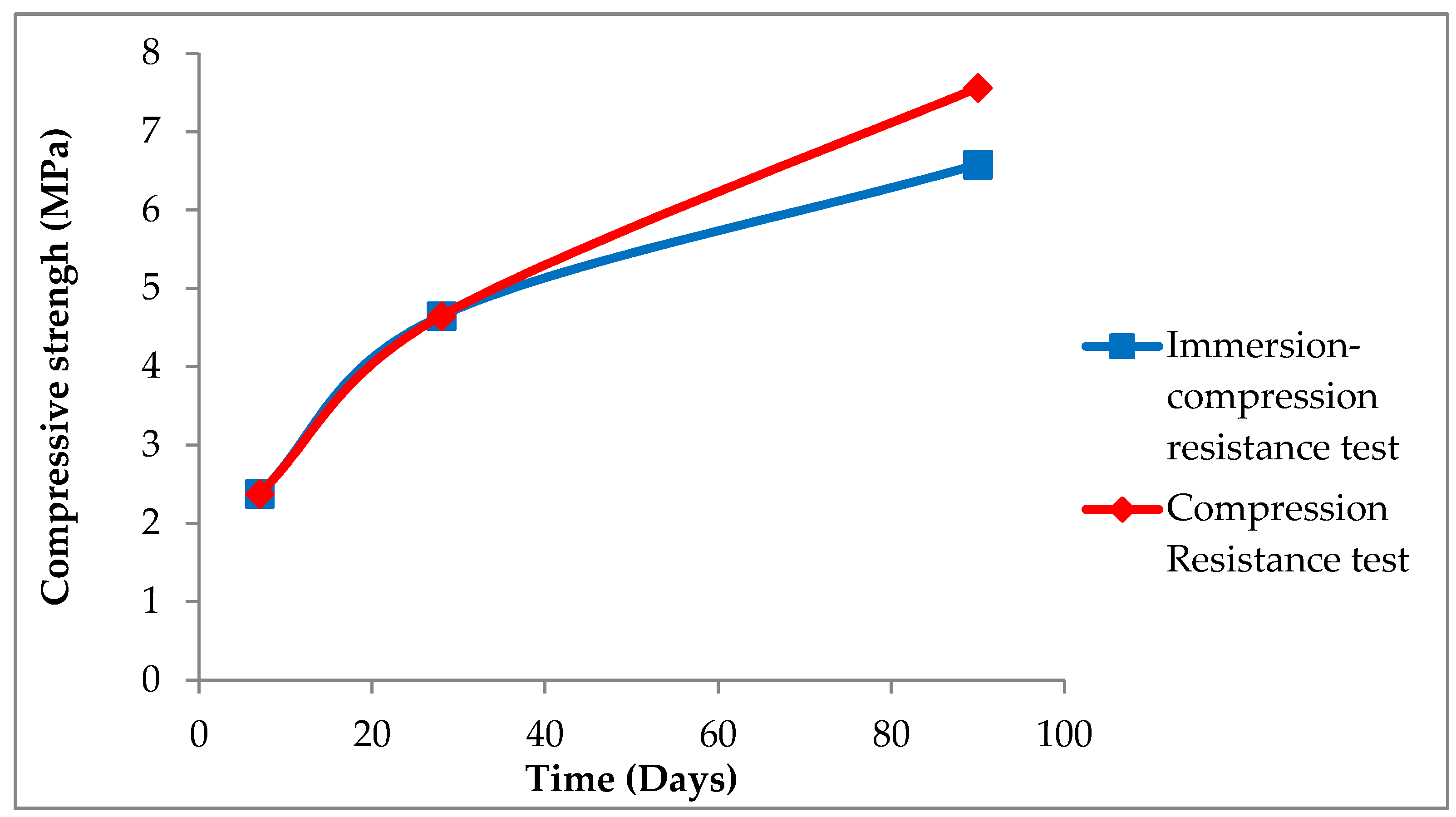
| Aperture | Retained among Tamices | |||
|---|---|---|---|---|
| UNE (mm) | Weight (g) | % Partial | % Accumulated | %Pass into Total Sample |
| 100 | - | - | - | - |
| 80 | - | - | - | - |
| 63 | - | - | - | - |
| 50 | - | - | - | - |
| 40 | - | - | - | - |
| 31.5 | - | - | - | - |
| 25 | - | - | - | - |
| 20 | - | - | - | - |
| 16 | - | - | - | - |
| 8 | - | - | - | 100.0 |
| 4.0 | 282.0 | 9.9 | 9.9 | 90.1 |
| 2.0 | 789.0 | 27.8 | 37.8 | 62.2 |
| 1.0 | 503.0 | 17.7 | 55.5 | 44.5 |
| 0.500 | 406.0 | 14.3 | 69.8 | 30.2 |
| 0.250 | 261.0 | 9.2 | 79.0 | 21.0 |
| 0.125 | 148.0 | 5.2 | 84.2 | 15.8 |
| 0.063 | 62.0 | 2.2 | 86.4 | 13.6 |
| Glass Powder Used | Grinding Duration | d10 | d50 | d90 |
|---|---|---|---|---|
| T1 | 2 h 30 min | 2.92 ± 0.01 µm | 33 ± 1 µm | 110 ± 3 µm |
| T2 | 4 h 15 min | 1.96 ± 0.01 µm | 16 ± 1 µm | 59 ± 2 µm |
| T3 | 5 h | 1.65 ± 0.01 µm | 11 ± 1 µm | 43 ± 2 µm |
| Liquid Limit | Plastic Limit | Plasticity Index |
|---|---|---|
| 34.5 | 19.4 | 15.1 |
| Specimen | CBR Index | Swelling (%) | Density (g/cm3) |
|---|---|---|---|
| 1 | 163 | 0.09 | 1.975 |
| 2 | 284 | 0.09 | 2.101 |
| 3 | 350 | 0.09 | 2.163 |
| Characteristics | |
|---|---|
| Mold volume (cm3) | 2320 |
| Compaction hammer (kg) | 4.535 |
| Fall height (cm) | 45.7 |
| Weight of material used (kg) | 24 |
| Number of layers | 5 |
| Number of hits per layer | 60 |
© 2020 by the authors. Licensee MDPI, Basel, Switzerland. This article is an open access article distributed under the terms and conditions of the Creative Commons Attribution (CC BY) license (http://creativecommons.org/licenses/by/4.0/).
Share and Cite
Más-López, M.I.; García del Toro, E.M.; Luizaga Patiño, A.; García, L.J.M. Eco-Friendly Pavements Manufactured with Glass Waste: Physical and Mechanical Characterization and Its Applicability in Soil Stabilization. Materials 2020, 13, 3727. https://doi.org/10.3390/ma13173727
Más-López MI, García del Toro EM, Luizaga Patiño A, García LJM. Eco-Friendly Pavements Manufactured with Glass Waste: Physical and Mechanical Characterization and Its Applicability in Soil Stabilization. Materials. 2020; 13(17):3727. https://doi.org/10.3390/ma13173727
Chicago/Turabian StyleMás-López, M. Isabel, Eva M. García del Toro, Alfredo Luizaga Patiño, and L. Jaime Marco García. 2020. "Eco-Friendly Pavements Manufactured with Glass Waste: Physical and Mechanical Characterization and Its Applicability in Soil Stabilization" Materials 13, no. 17: 3727. https://doi.org/10.3390/ma13173727
APA StyleMás-López, M. I., García del Toro, E. M., Luizaga Patiño, A., & García, L. J. M. (2020). Eco-Friendly Pavements Manufactured with Glass Waste: Physical and Mechanical Characterization and Its Applicability in Soil Stabilization. Materials, 13(17), 3727. https://doi.org/10.3390/ma13173727





